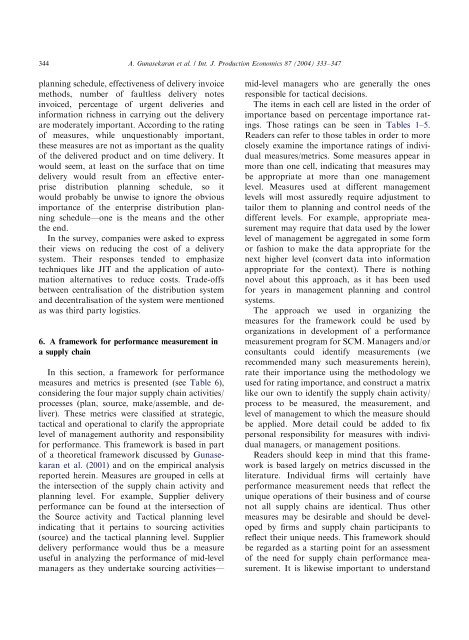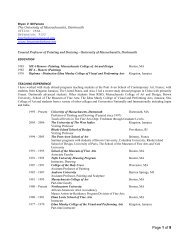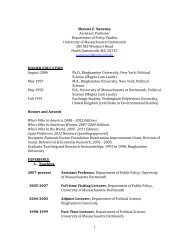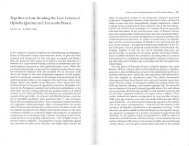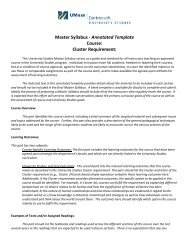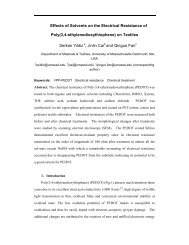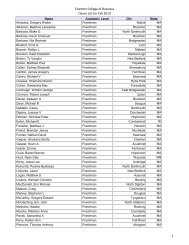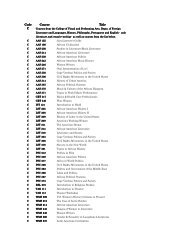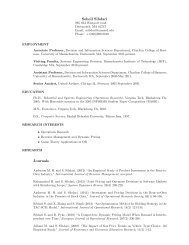A framework for supply chain performance measurement
A framework for supply chain performance measurement
A framework for supply chain performance measurement
Create successful ePaper yourself
Turn your PDF publications into a flip-book with our unique Google optimized e-Paper software.
ARTICLE IN PRESS344A. Gunasekaran et al. / Int. J. Production Economics 87 (2004) 333–347planning schedule, effectiveness of delivery invoicemethods, number of faultless delivery notesinvoiced, percentage of urgent deliveries andin<strong>for</strong>mation richness in carrying out the deliveryare moderately important. According to the ratingof measures, while unquestionably important,these measures are not as important as the qualityof the delivered product and on time delivery. Itwould seem, at least on the surface that on timedelivery would result from an effective enterprisedistribution planning schedule, so itwould probably be unwise to ignore the obviousimportance of the enterprise distribution planningschedule—one is the means and the otherthe end.In the survey, companies were asked to expresstheir views on reducing the cost of a deliverysystem. Their responses tended to emphasizetechniques like JIT and the application of automationalternatives to reduce costs. Trade-offsbetween centralisation of the distribution systemand decentralisation of the system were mentionedas was third party logistics.6. A <strong>framework</strong> <strong>for</strong> per<strong>for</strong>mance <strong>measurement</strong> ina <strong>supply</strong><strong>chain</strong>In this section, a <strong>framework</strong> <strong>for</strong> per<strong>for</strong>mancemeasures and metrics is presented (see Table 6),considering the four major <strong>supply</strong> <strong>chain</strong> activities/processes (plan, source, make/assemble, and deliver).These metrics were classified at strategic,tacticaland operationalto clarify the appropriatelevel of management authority and responsibility<strong>for</strong> per<strong>for</strong>mance. This <strong>framework</strong> is based in partof a theoretical<strong>framework</strong> discussed by Gunasekaranet al. (2001) and on the empiricalanalysisreported herein. Measures are grouped in cells atthe intersection of the <strong>supply</strong> <strong>chain</strong> activity andplanning level. For example, Supplier deliveryper<strong>for</strong>mance can be found at the intersection ofthe Source activity and Tactical planning levelindicating that it pertains to sourcing activities(source) and the tactical planning level. Supplierdelivery per<strong>for</strong>mance would thus be a measureuseful in analyzing the per<strong>for</strong>mance of mid-levelmanagers as they undertake sourcing activities—mid-level managers who are generally the onesresponsible <strong>for</strong> tactical decisions.The items in each cell are listed in the order ofimportance based on percentage importance ratings.Those ratings can be seen in Tables 1–5.Readers can refer to those tables in order to moreclosely examine the importance ratings of individualmeasures/metrics.Some measures appear inmore than one cell, indicating that measures maybe appropriate at more than one managementlevel. Measures used at different managementlevels will most assuredly require adjustment totailor them to planning and control needs of thedifferent levels. For example, appropriate <strong>measurement</strong>may require that data used by the lowerlevel of management be aggregated in some <strong>for</strong>mor fashion to make the data appropriate <strong>for</strong> thenext higher level (convert data into in<strong>for</strong>mationappropriate <strong>for</strong> the context). There is nothingnovelabout this approach, as it has been used<strong>for</strong> years in management planning and controlsystems.The approach we used in organizing themeasures <strong>for</strong> the <strong>framework</strong> could be used byorganizations in development of a per<strong>for</strong>mance<strong>measurement</strong> program <strong>for</strong> SCM. Managers and/orconsultants could identify <strong>measurement</strong>s (werecommended many such <strong>measurement</strong>s herein),rate their importance using the methodology weused <strong>for</strong> rating importance, and construct a matrixlike our own to identify the <strong>supply</strong> <strong>chain</strong> activity/process to be measured, the <strong>measurement</strong>, andlevel of management to which the measure shouldbe applied. More detail could be added to fixpersonalresponsibility <strong>for</strong> measures with individualmanagers,or management positions.Readers should keep in mind that this <strong>framework</strong>is based largely on metrics discussed in theliterature. Individual firms will certainly haveper<strong>for</strong>mance <strong>measurement</strong> needs that reflect theunique operations of their business and of coursenot all <strong>supply</strong> <strong>chain</strong>s are identical. Thus othermeasures may be desirable and should be developedby firms and <strong>supply</strong> <strong>chain</strong> participants toreflect their unique needs. This <strong>framework</strong> shouldbe regarded as a starting point <strong>for</strong> an assessmentof the need <strong>for</strong> <strong>supply</strong> <strong>chain</strong> per<strong>for</strong>mance <strong>measurement</strong>.It is likewise important to understand


